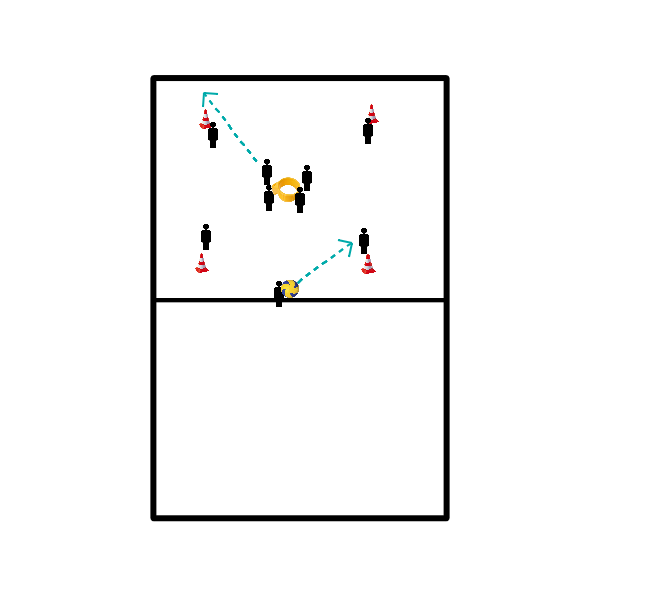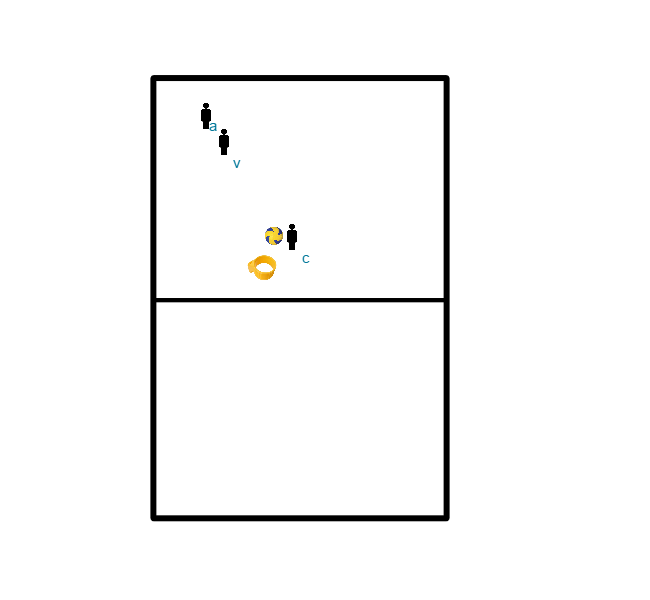Korfball drills for technique attack / score
Inshort: a ball game, in which pure throwing is very important.
Organisation: In a rectangle of approx. 20 metres length and 10 metres width, two teams of about 6 players are lined up. A centre line divides the field in two. At both back sides is a strip of 1 to 2 metres wide. The players of side A stand in section A, while one player from A stands in lane A. The players of side B stand, except for one player, in section B. The players must try to hit the players of the other side with the ball. They are not allowed to leave their section. Furthermore the players are not allowed to run with the ball in their hands. Fending with the hands is allowed. If a player is hit, he goes to the back of the court and plays with the ball. Will one of the players succeed in clearing the other team's box? Make sure the hunters do not start throwing hard. If this is likely to cause problems, decide that the throw can only be made via a bounce. Make sure they do not start throwing very hard. If this threatens to cause problems, determine that only a bumping throw may be made.
Variations:
1 ) If a player can catch a ball from the opposing team, the player who threw is off.
2 ) Exchange referee: if a player from the back lane hits the ball, he may return to his own section.
3 ) The strips at the back are extended with side strips, so that the compartments are completely enclosed.
In short: practising fast starting and high jumping in duels for the ball.
Organisation: Each team of three (about the same size) a ball and a piece of the hall or the field.
Jump ball or referee throw. The numbers 2 and 3 stand close together at a few metres from number 1. The numbers 2 and 3 must try to get it first. Who wins the duel the most? After two substitutions.
Numbers 2 and 3 stand right next to each other at about 7 metres in front of number 1. Numbers 2 and 3 sprint towards it and try to catch the ball before it falls to the ground. After, for example, 8 changes, the second change is made after another 8 changes.
Number 1 stands between numbers 2 and 3. He rolls the ball a bit away. As soon as the ball has left the hands, numbers 2 and 3 may start. Who will get the ball first? Number 1 may also make feint throws. Physical contact will occur during these exercises. This is officially forbidden, but everyone knows that it happens and that a lot of it is allowed or not noticed by the referees. It is therefore sensible to practise starting and jumping with an opponent around who will touch you lightly or give you a push now and then (whether intentionally or not). Experience has also taught me that some players who actually lose all duels during matches (or even avoid them), can play much 'harder' after doing this exercise one or more times if they have to. And sometimes even like to do so... Enough about this, it seems to me that this is not the place to point out how opponents can be trumped by physical violence.
As above, but now the trio are standing at about 10 metres from a line. Who is first to catch the ball rolled away by number 1 before it rolls over the line, number 2 or number 3? Note: it is not allowed to 'slip' over the line. If for instance number 2 manages to keep the ball in by holding it back for a moment, but does not come to a stop before the line, then there is still a nice possibility for number 3, who fell behind, to grab the ball first!
The numbers 2 and 3 stand close together at a few metres distance from number 1. Who will get the ball first?
With 3 players at the basket, 1 attacker with the ball under the basket and 2 players who shoot the ball in motion (minimum distance 5 meters
). The attacker who is first to score 3 goals may remain in front of the basket and the attacker who has lost the game must take the place of the attacker.
1 pole, 1 ball, 4 hats in a square and 9 playersThe
4 attackers stand in a square (near the hats) around the basket, the 4 defenders hold the pole with one hand. The 9th person (the declarer) stands with the ball outside the square of the hats. The attacker passes the ball to one of the attackers, the defender who stands opposite the attacker who receives the ball must run around the hat and the attackers must now score as quickly as possible. If all goes well, the attackers quickly find the person who is free, as one of the defenders has to run around the hat-trick

3 men per basket. Player A starts as attacker in front of the basket. Player V starts as defender at 1,5 arm's length from the shooter. Player C starts with the ball in the box. Attacker A must try to score through the 1 on 1 duel. It does not matter how (distance, evasion, dlb). The defender's task is to follow the attacker at 1,5 arm's length and when the attacker has the ball in his hands, the defender has to close the gap. The defender is not allowed to tap or block balls. The V must show that she is with the attacker, but must allow the shot. This can be done by the defender placing her hand just above the shoulder of the attacker. After 1 minute, the V has to change position.
Korfball in 1 section. An attacking and a defending side, preferably 4 against 4, possibly with substitutes.
The attacking side puts the ball in play and tries to score a goal. After scoring or intercepting, the defending side attacks.
In the first case, the ball is taken out about 15 m. in front of the basket, in the second case it is first combined to this starting point.
The attacking side may try to intercept after losing the ball. If this is successful before the ball has been played to the starting point, then a goal opportunity may be played directly.
Note:
Emphasis is on playing the ball out well and defending consistently.
Variation:
After a goal, the attacking side keeps the attacking position. The team plays 2 minutes on ball possession. If the team succeeds in keeping the ball in the team for that long, or in scoring another goal, the goal is valid. If the defence intercepts the ball, the point is forfeited.
 3 men per basket. Player A starts as attacker in front of the basket. Player V starts as defender at 1,5 arm's length from the shooter. Player C starts with the ball in the box. Attacker A must try to score through the 1 on 1 duel. It does not matter how (distance, evasion, dlb). The defender's task is to follow the attacker at 1,5 arm's length and when the attacker has the ball in his hands, the defender has to close the gap. The defender is not allowed to tap or block balls. The V must show that she is with the attacker, but must allow the shot. This can be done by the defender placing her hand just above the shoulder of the attacker. After 1 minute, the V has to change position.
3 men per basket. Player A starts as attacker in front of the basket. Player V starts as defender at 1,5 arm's length from the shooter. Player C starts with the ball in the box. Attacker A must try to score through the 1 on 1 duel. It does not matter how (distance, evasion, dlb). The defender's task is to follow the attacker at 1,5 arm's length and when the attacker has the ball in his hands, the defender has to close the gap. The defender is not allowed to tap or block balls. The V must show that she is with the attacker, but must allow the shot. This can be done by the defender placing her hand just above the shoulder of the attacker. After 1 minute, the V has to change position.
You make a square, in it stands an attacker, the attacker must keep moving in the square while a defender walks by. 1 person always plays the ball. The defender looks at the ball and tries to catch it. Every time the attacker catches the ball, someone else comes into the box. When the defender catches the ball, he throws it back and you try again.
You make a square, in it stands an attacker, the attacker must keep moving in the square while a defender walks by. 1 person always plays the ball. The defender looks at the ball and tries to catch it. Every time the attacker catches the ball, someone else comes into the box. When the defender catches the ball, he throws it back and you try again.
At the end of the training, play a game of 4 against 4 on 1 basket.
Organisation:
Two parties, 1 attacking and 1 defending party. Three or four baskets and a ball.
Exercise:
How much time does a team need to score a goal in all the baskets?
The basket that has been scored in may not be used again, so that the difficulty factor increases. The defender gives the ball back after interception.
Organization:
Pairs together, two players (men/ladies these are A(attacker) and V(defender) in front of the picture) in the left corner in front of the basket.Â
One player left (left behind the basket) next to it and one player right (right behind the basket) next to it.Â
In the pair is an attacker and a defender. The attacker has the ball, places it next to him (left or right) and takes the rebound. The defender makes the rebound difficult but gives it away initially (defends in front).
The player who does not get the ball fills the place of the attacker/rebounder. The two players in front of the basket take a shot after one or two doubles.
* Out of the five shots, who grabs the most rebounds?
Correct for:
Blocking out under the basket, keeping the opponent in the back and preferably in front of the basket, defending in front by the defender and only engaging in the duel when the shot is in the air.
Formation:







